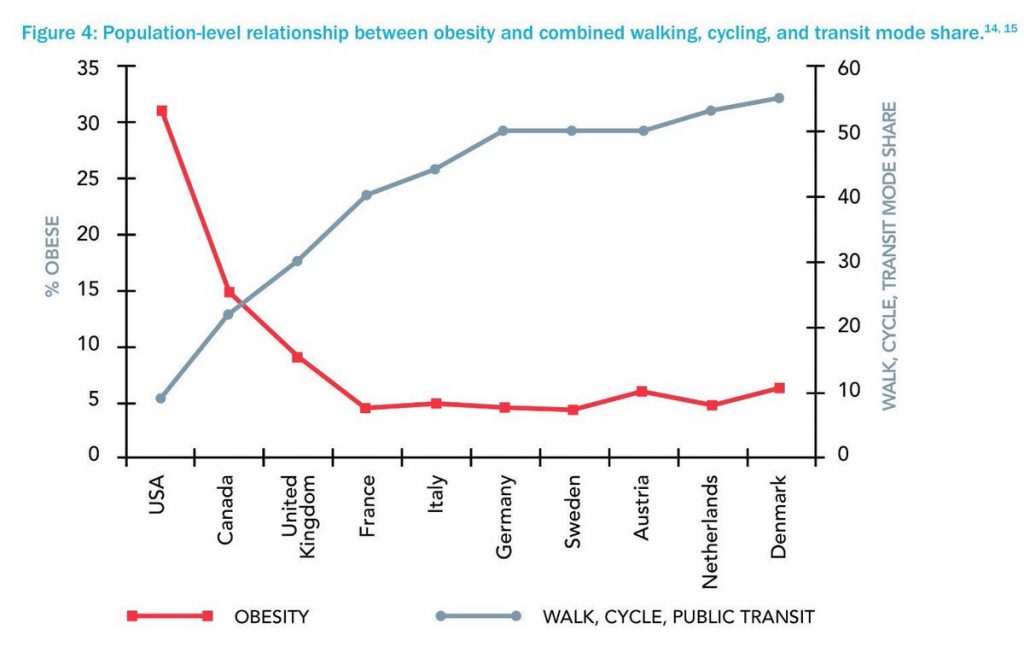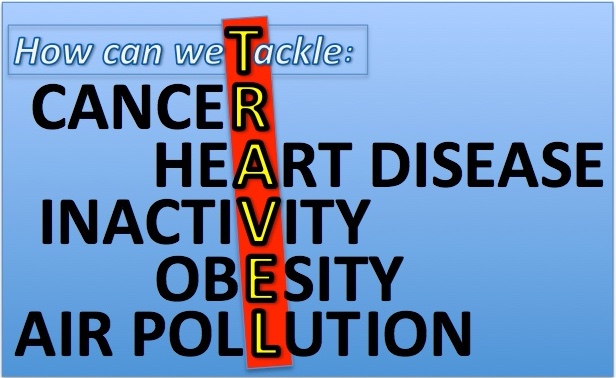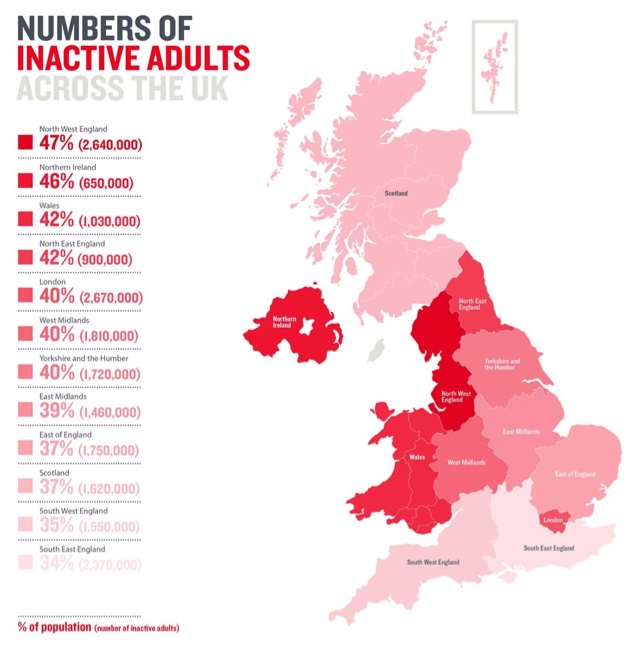On 12 April, six days before the General Election was announced, the Evening Standard published an article quoting Theresa May stating that toxic air pollution is the fourth biggest public health risk behind cancer, obesity and heart disease.
While there are multiple causes for each of these public health risks,
we can dramatically reduce the impact of all these risks – and more –
by changing how we travel.
Clearly this is true for air pollution. The Draft UK Air Quality Plan for tackling nitrogen dioxide published on 5 May 2017 confirms that “road transport is responsible for some 80% of NOx concentrations at roadside, with diesel vehicles the largest source in these local areas of greatest concern“. Poor air quality is responsible for 40,000 early deaths each year. [Royal College of Physicians]
It is also true for cancer and heart disease. On 20 April 2017 the BBC reported on a study of 250,000 people over 5 years showing how much cancer and heart disease figures could be reduced by if people walked or cycled to work. This found that “regular cycling cut the risk of death from any cause by 41%, the incidence of cancer by 45% and heart disease by 46%.“, while walking to work reduced the risk of death from heart disease by 36%.
A study of obesity in Europe and North America showed that “Countries with the highest levels of active transportation generally had the lowest obesity rates.” Obesity is estimated to be responsible for 30,000 early deaths each year. [Public Health England]
 Walking, Cycling, and Obesity Rates in Europe, North America, and Australia from The Journal of Physical Activity and Health
Walking, Cycling, and Obesity Rates in Europe, North America, and Australia from The Journal of Physical Activity and Health
Inactivity has been shown to be responsible for many more early deaths than obesity. According to the British Heart Foundation Physical Activity Report 2017 42% of adults in the North East are classed as being inactive.
It is estimated that one in six deaths every year are directly due to inactivity. This is about 84,500 in England and Wales. Sedentary lifestyles: are also linked to increased pressure on (and costs of) social care.
Walking or cycling to work can also cut the chances of developing diabetes by 40-50% as well as reducing the prevalence of dementia.
In our blog Blue House – at what cost to health? we set out some of the other health risks of pollution including: reduced lung capacity and cognitive delay for children and links to dementia, infertility and sperm damage.
Walking and cycling also have a proven positive benefit to mental health. A study of 18,000 adults found that “Those who had an active commute were found to have a higher level of well-being than those who went by car or public transport. When researchers analysed the wellbeing of a small group who swapped the car or bus for a bike or going on foot, they found they became happier after the switch.”
A separate study of 20,000 children found that “Children who walk or cycle to school rather than being driven by their parents have an increased power of concentration, and the effect of this ‘exercise’ lasts all morning.”
The case for Investing in Walking and Cycling
All these reasons show why the new Cycling and Walking Investment Strategy (CWIS) and associated investment is so important.
As well as improving health, investing in walking and cycling has also been shown to:
- Increase mobility for everyone and create more choice for how we travel
- Help children travel safely and independently
- Extend the reach of public transport
- Improve mobility for people with disabilities
- Reduce the cost of travel (cycling rather than driving is equivalent to a 8% pay rise)
- Reduce the cost of infrastructure spending and of local deliveries
- Reduce overall energy usage
- Reduce road danger and noise
- Improve access to work opportunities for the unemployed
- Lead to a fitter, healthier, more productive workforce
- Improve the environment
- Reduce dependence on foreign oil
- Increase community cohesion “(positive interactions among neighbours due to more people walking on local streets) which tends to increase local security“
- Increase retail sales
- Increase property values
This doesn’t have to take a generation but it does require ambition. In Seville, the actions they took led to the number of bike trips multiplying 11-fold in a just few years. By contrast the UK CWIS states the aim that it “wants cycling and walking to become the norm by 2040” – about 20 years slower (and with 20 years of lost benefit) compared to what has already been achieved by Seville.
Taken together, the benefits associated with walking and cycling schemes are typically far greater than those for other transport projects, potentially worth a £17bn saving for the NHS. They are also financially achievable within the existing transport budget by diverting spend from projects with lower returns on investment.
What you can do
You can respond to the Government consultation on air pollution up to 15 June 2017.
And please keep sharing your thoughts on how we can improve Gosforth to encourage more people to walk (or cycle) via our National Walking Month post.
Further links
- Effect of increasing active travel in urban England and Wales on costs to the National Health Service
- Evaluating Active Transport Benefits and Costs by the Victoria Transport Policy Institute
- The Business Case for Active Transportation by Better Environmentally Sound Transportation
- The Value of Cycling, a report for the UK Department of Transport
- Walking for Health, NHS
- Bicycling to work decreased risk of mortality in approximately 40% after multivariate adjustment, including leisure time physical activity.
- Benefits of Walking and Cycling – National Institute for Clinical Excellence (NICE)



This is a reference to a related study.
“The study indicates measures that avoid urban sprawl, increase car use pricing and provisions for active and public transport are among the most beneficial to health. These measures have the potential to reduce air pollution, noise, greenhouse gases, social exclusion, community mobility, car crashes, increase or protect available green space and encourage walking and cycling.”
http://www.its.leeds.ac.uk/about/news/health-impact-of-transport-policies/
“How Dutch Cycling benefits society” – A blog by Bicycle Dutch, 2 January 2019
“Cycling is very good for a society. The Dutch approach to cycling can help achieve accessibility, liveability, sustainability and health goals. The 17 million Dutch own almost 23 million bicycles and a quarter of all trips – nationwide – are made by bicycle. Still the Dutch Government earmarked a quarter of a billion euros to get another 200,000 commuters out of their car and onto their bicycles…”
https://bicycledutch.wordpress.com/2019/01/02/how-dutch-cycling-benefits-society/
“A social justice case for walking and cycling” by ROBERT STEUTEVILLE DEC. 21, 2018
“Automobiles are expensive to buy and maintain. That’s the reason why lower-income workers need choices in transportation, especially choices that allow them to get to work using their own power—without any day-to-day costs at all…”
https://www.cnu.org/publicsquare/2018/12/21/social-justice-case-walking-and-cycling
The economic benefits of walking and cycling
Published 6 November 2014 From: Department for Transport
https://www.gov.uk/government/publications/economic-case-for-active-travel-the-health-benefits
“This report compiles the latest cost-benefit evidence from studies that have calculated health benefits, alongside other benefits such as savings in travel time, congestion and accidents.
“The typical benefit-cost ratios are considerably greater than the threshold of 4:1 which is considered by the Department for Transport as ‘very high’ value for money. This supports the conclusion that small-scale transport schemes can really deliver high value for money.”
“Why cycling is good for everything from retail sales to property prices”
https://cyclingindustry.news/why-cycling-is-good-for-everything-from-retail-sales-to-property-prices/
“May 7, 2021 – A new cost-benefit study in New Zealand finds that investments in cycling and walking facilities outweigh the costs of building them by ten to one”
https://idealog.co.nz/urban/2018/05/new-victoria-university-wellington-study-biking-and-walking-pays-so-will-more-nz-cities-catch
Premature Mortality of 2050 High Bike Use Scenarios in 17 Countries
“We found that, among the urban populations (20–64 y old) of 17 countries, 205,424 annual premature deaths could be prevented if high bike-use scenarios are achieved by 2050 (assuming that 100% of bike trips replace car trips). If only 8% of bike trips replace car trips in a more conservative scenario, 18,589 annual premature deaths could be prevented by 2050 in the same population. In all the countries and scenarios, the mortality benefits related to bike use (rather than car use) outweighed the mortality risks.”
https://ehp.niehs.nih.gov/doi/full/10.1289/EHP9073#.YbMVAGQcesk.twitter
Transport noise linked to increased risk of dementia, study finds
Large survey involving two million adults found links between road and rail traffic and Alzheimer’s in particular
https://www.theguardian.com/society/2021/sep/09/transport-noise-linked-to-increased-risk-of-dementia-study-finds
50 Reasons Why Everyone Should Want More Walkable Streets
From making you live longer to making cities more resilient: If you want a reason to make your city more walkable, it’s in here.
https://www.fastcompany.com/3062989/50-reasons-why-everyone-should-want-more-walkable-streets
people who rode bikes 30 min/day had 30% lower risk of developing colon cancer, compared to people who didn’t ride.
people who biked 45 min/day had 20% lower risk of developing breast cancer, compared to people who didn’t ride.
people who biked to work had 45% lower risk of developing cancer and 46% lower risk of dying from cancer, compared to people who didn’t bike commute.
Risk of developing cancer was lower for people who were more physically active, based on 1.2 million participants of 46 different studies.
Risk of developing cancer was lower for people who were more physically active, based on 2.4 million participants of 51 different studies.
Studies about cancer medicine are abundant. Doctors should prescribe more cycling.
The Effect of Cycling on Cancer Risk by the American Cancer Society
The Role of Physical Activity in Cancer Prevention by the National Cancer Institute
Cycling for Health by the World Health Organization
The Health Benefits of Cycling by the Mayo Clinic
Cycling and Cancer Prevention: A Review of the Evidence by the Journal of the National Cancer Institute
As a bonus, active transportation is excellent medicine for: Reducing the risk of heart disease
Reducing the risk of stroke
Reducing the risk of obesity
Reducing the risk of type 2 diabetes
Improving mental health
Increasing life expectancy
Source: https://twitter.com/Boenau/status/1657400451334041600?s=20
Road space reallocation in Scotland: A health impact assessment
• Road space reallocation is likely to benefit health and equity through multiple pathways.
• Alternative transport modes should be enhanced.
• Reallocated space should be designed to create accessible, high quality environments.
• Consultation should focus on best alternatives uses of public space.
• Health impact assessment can make explicit the potential benefits and harms of proposed developments.
https://www.sciencedirect.com/science/article/pii/S2214140523000610